Brooklyn-Queens Expressway North Old Kosciuszko Bridge 2001
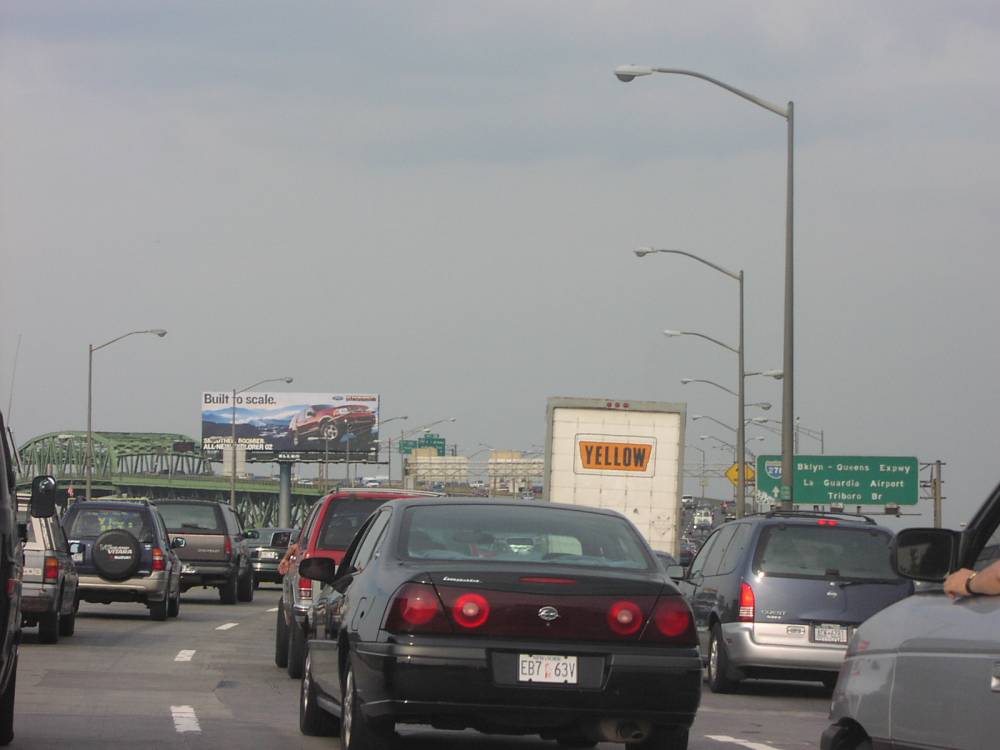 Back in 1999 we traveled south on the Brooklyn Queens Expressway over the ultimately doomed, late 1930s vintage Kosciuszko Bridge. Two and a half years later, in August 2001, we're finally making the trip back north from Greenpoint in Brooklyn to Maspeth, Queens.
I always liked the Yellow trucks logo. Who knows why. Must've been a very effective design if it grabbed my affections that much. I hope the man who designed it got paid accordingly. Since it was probably a starving artist during the Great Depression, he probably didn't.
Back in 1999 we traveled south on the Brooklyn Queens Expressway over the ultimately doomed, late 1930s vintage Kosciuszko Bridge. Two and a half years later, in August 2001, we're finally making the trip back north from Greenpoint in Brooklyn to Maspeth, Queens.
I always liked the Yellow trucks logo. Who knows why. Must've been a very effective design if it grabbed my affections that much. I hope the man who designed it got paid accordingly. Since it was probably a starving artist during the Great Depression, he probably didn't.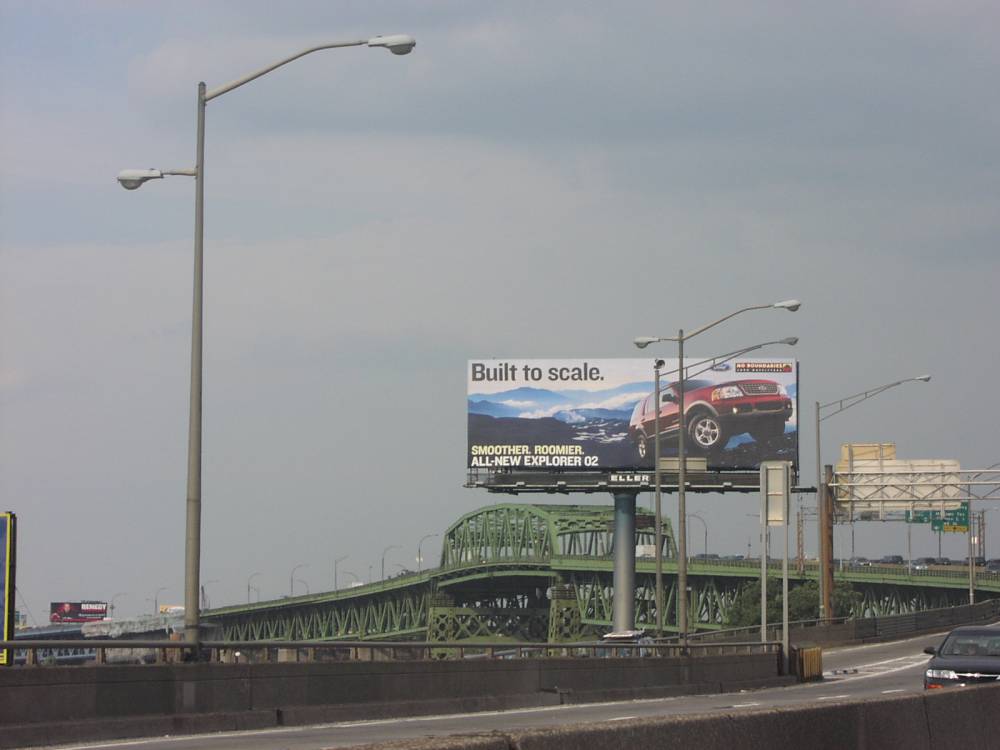 While the then brand new, just out of the factory Ford Explorer might have been built to scale, the same can't be said of the twin masted lamp post doing double duty lighting up both the main southbound descent lanes coming off the Kosciuszko Bridge and the off ramp descending even further down to Meeker Avenue, the poor service road that was cruelly teased in the 1930s with visions of becoming Greenpoint's Queens Boulevard, or at least their Woodhaven Boulevard. Back then Meeker Avenue was thee approach road to and from the Kosciuszko, as the Brooklyn Queens Expressway was not built here until after World War II. As part of the bridge construction, Meeker was quote unquote improved, which doubtless meant it was significantly widened to handle the bridge traffic.
At least Meeker was led to believe that. Little did it know a dozen years later it would be buried in the shadows of a monstrous elevated arterial highway, getting dripped on constantly by the potent gasoline and oil polluted storm runoff that would leak from corroding highway joints.
Ah yes, the Meeker thought the Meeker would inherit the earth, at least the earth under who knows how many buildings disappeared during its widening. Instead it inherited a big, rusting, elongated umbrella.
But oh did I digress. We were supposed to be talking about a lamp post that wasn't quite built to scale. Notice the second of the two mast arms, the first being a standard length elliptical arm? Well the second is what I lovingly termed The Parasite, this little Rosemary's Baby thing sticking out of the lighting standard in a very asymmetrical spot. It's like a mad scientist decided to try his hand at streetlight design. What can I say? These are the kind of things I devote my brain power to.
While the then brand new, just out of the factory Ford Explorer might have been built to scale, the same can't be said of the twin masted lamp post doing double duty lighting up both the main southbound descent lanes coming off the Kosciuszko Bridge and the off ramp descending even further down to Meeker Avenue, the poor service road that was cruelly teased in the 1930s with visions of becoming Greenpoint's Queens Boulevard, or at least their Woodhaven Boulevard. Back then Meeker Avenue was thee approach road to and from the Kosciuszko, as the Brooklyn Queens Expressway was not built here until after World War II. As part of the bridge construction, Meeker was quote unquote improved, which doubtless meant it was significantly widened to handle the bridge traffic.
At least Meeker was led to believe that. Little did it know a dozen years later it would be buried in the shadows of a monstrous elevated arterial highway, getting dripped on constantly by the potent gasoline and oil polluted storm runoff that would leak from corroding highway joints.
Ah yes, the Meeker thought the Meeker would inherit the earth, at least the earth under who knows how many buildings disappeared during its widening. Instead it inherited a big, rusting, elongated umbrella.
But oh did I digress. We were supposed to be talking about a lamp post that wasn't quite built to scale. Notice the second of the two mast arms, the first being a standard length elliptical arm? Well the second is what I lovingly termed The Parasite, this little Rosemary's Baby thing sticking out of the lighting standard in a very asymmetrical spot. It's like a mad scientist decided to try his hand at streetlight design. What can I say? These are the kind of things I devote my brain power to.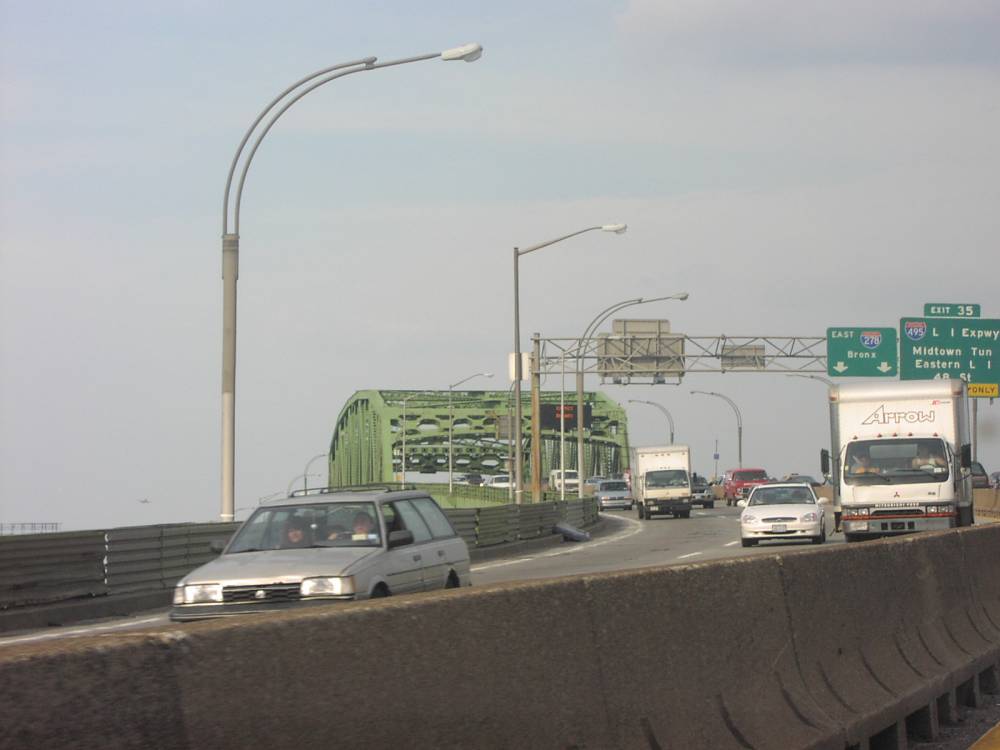 Getting closer to center span as we keep on rising to the top, to quote rap singer Agallah. His rap ditty Rising to the Top would soon be a big thing as video game Grand Theft Auto III was released a couple of months after I shot this following 9-11 and sales took off into the stratosphere.
On the right we are once again obsessed with lighting standards. We're no longer dealing with otherwise normal plain vanilla poles sporting abnormal parasitic mast arm appendages. Instead we're staring at the elongated highway version of the Donald Deskey designed SLECO aluminum standard that New York City commissioned back in the late 1950s. The design was such that myriad mast arms could be slipped into place in one of 2 grooves carved into the sides. They were of course rust free, being aluminum and part of their allure was undoubtedly being maintenance free. Their standard length mast arms were like little davit poles themselves. Technically they probably would be classed as uplift style arms. Extra wide roads like this highway would occasionally get longer mast arms that required the additional brace you see tied to it here.
The SLECOs were apparently intended to replace everything standing in the city, from lamp posts to traffic signal posts to probably even sign posts and maybe, just maybe, utility poles. I wouldn't even put it past them to have envisioned Donald Deskey flag poles outside every school and public building.
Instead they managed to replace a lot of decaying cast iron posts and a gaggle of hex pole standards, usually those who had the misfortune of being spot replacements for fallen cast irons on blocks still dominated by surviving cast irons. It just wasn't considered symmetrical to have a hex pole on one corner and a Deskey across from it. They were viewed as sets; one corner, one pole design.
Their victory was quite incomplete however. While they did take over virtually every arterial highway and many secondary and side streets, they were already in decline by their twentieth birthdays and today they are the oddball survivors, just waiting around morosely for the next great reconstruction project to totally wipe them out. This long masted example and all its Kosciuszko Bridge buddies did thus get wiped out, if they were even there that late, when their bridge was wiped out in 2017.
Getting closer to center span as we keep on rising to the top, to quote rap singer Agallah. His rap ditty Rising to the Top would soon be a big thing as video game Grand Theft Auto III was released a couple of months after I shot this following 9-11 and sales took off into the stratosphere.
On the right we are once again obsessed with lighting standards. We're no longer dealing with otherwise normal plain vanilla poles sporting abnormal parasitic mast arm appendages. Instead we're staring at the elongated highway version of the Donald Deskey designed SLECO aluminum standard that New York City commissioned back in the late 1950s. The design was such that myriad mast arms could be slipped into place in one of 2 grooves carved into the sides. They were of course rust free, being aluminum and part of their allure was undoubtedly being maintenance free. Their standard length mast arms were like little davit poles themselves. Technically they probably would be classed as uplift style arms. Extra wide roads like this highway would occasionally get longer mast arms that required the additional brace you see tied to it here.
The SLECOs were apparently intended to replace everything standing in the city, from lamp posts to traffic signal posts to probably even sign posts and maybe, just maybe, utility poles. I wouldn't even put it past them to have envisioned Donald Deskey flag poles outside every school and public building.
Instead they managed to replace a lot of decaying cast iron posts and a gaggle of hex pole standards, usually those who had the misfortune of being spot replacements for fallen cast irons on blocks still dominated by surviving cast irons. It just wasn't considered symmetrical to have a hex pole on one corner and a Deskey across from it. They were viewed as sets; one corner, one pole design.
Their victory was quite incomplete however. While they did take over virtually every arterial highway and many secondary and side streets, they were already in decline by their twentieth birthdays and today they are the oddball survivors, just waiting around morosely for the next great reconstruction project to totally wipe them out. This long masted example and all its Kosciuszko Bridge buddies did thus get wiped out, if they were even there that late, when their bridge was wiped out in 2017.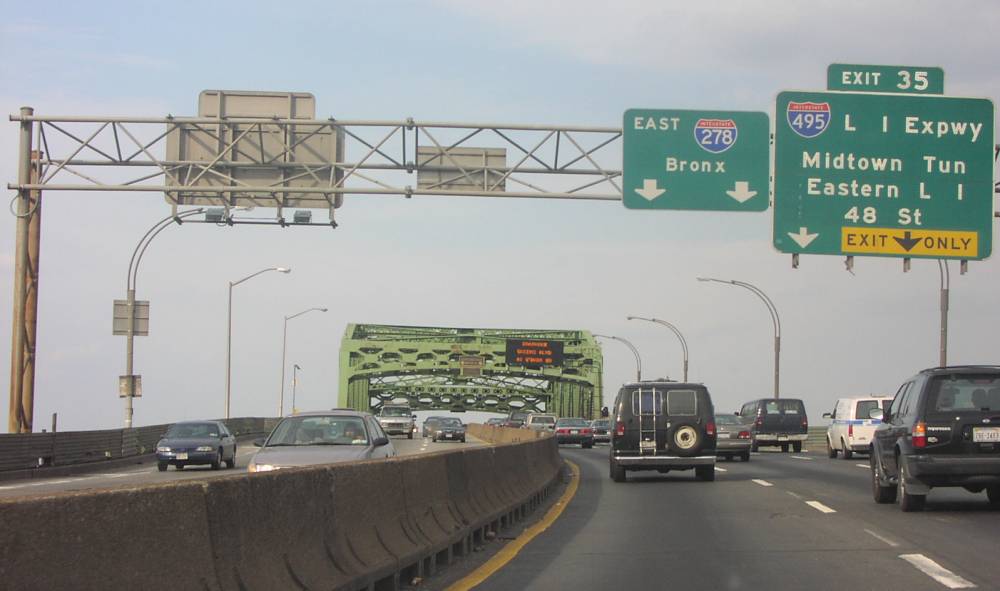 The nervous nanny state wants to make sure you're ready and in the lane you need to be in if you intend to get off onto the Long Island Expressway. Doesn't matter that you haven't even reached center span yet. Actually I applaud early warning directionals that give you proper time to change lanes. One of my pet peeves are Interstate highway junctions where you're on the local street leading to them and you see the little blue and red shield signs telling you the entrance is just up ahead, but they don't tell you whether it will be to the left or the right until you're right on top of it.
Remember what I wrote in the prior paragraph about the Deskey poles being in decline? You've now seen how every other pole or so there's a standard pole between Deskey survivors, because every Deskey that gets knocked down gets replaced by something a lot blander. Deskeys are no longer produced.
You might wonder how a pole fixed to what these are even gets knocked down. Well, never under estimate the power of wind storms. Bolts loosen. Wiring goes bad and its easier to just take the pole off and wire a lighter, cheaper one in its place and sell the SLECO for scrap, than to go lowering it onto the roadbed and start pulling its guts out to rewire the thing. And occasionally vehicles do hit the retaining wall they sit atop, sometimes very big vehicles. They may not damage the wall, but they shake the poles loose and bam, you don't want to be in a little fishing skiff below when a Deskey falls into the water. Frankly you don't want to eat any fish coming from that water, that being Newtown Creek. Frankly you don't want to be a fish in that water either.
The nervous nanny state wants to make sure you're ready and in the lane you need to be in if you intend to get off onto the Long Island Expressway. Doesn't matter that you haven't even reached center span yet. Actually I applaud early warning directionals that give you proper time to change lanes. One of my pet peeves are Interstate highway junctions where you're on the local street leading to them and you see the little blue and red shield signs telling you the entrance is just up ahead, but they don't tell you whether it will be to the left or the right until you're right on top of it.
Remember what I wrote in the prior paragraph about the Deskey poles being in decline? You've now seen how every other pole or so there's a standard pole between Deskey survivors, because every Deskey that gets knocked down gets replaced by something a lot blander. Deskeys are no longer produced.
You might wonder how a pole fixed to what these are even gets knocked down. Well, never under estimate the power of wind storms. Bolts loosen. Wiring goes bad and its easier to just take the pole off and wire a lighter, cheaper one in its place and sell the SLECO for scrap, than to go lowering it onto the roadbed and start pulling its guts out to rewire the thing. And occasionally vehicles do hit the retaining wall they sit atop, sometimes very big vehicles. They may not damage the wall, but they shake the poles loose and bam, you don't want to be in a little fishing skiff below when a Deskey falls into the water. Frankly you don't want to eat any fish coming from that water, that being Newtown Creek. Frankly you don't want to be a fish in that water either.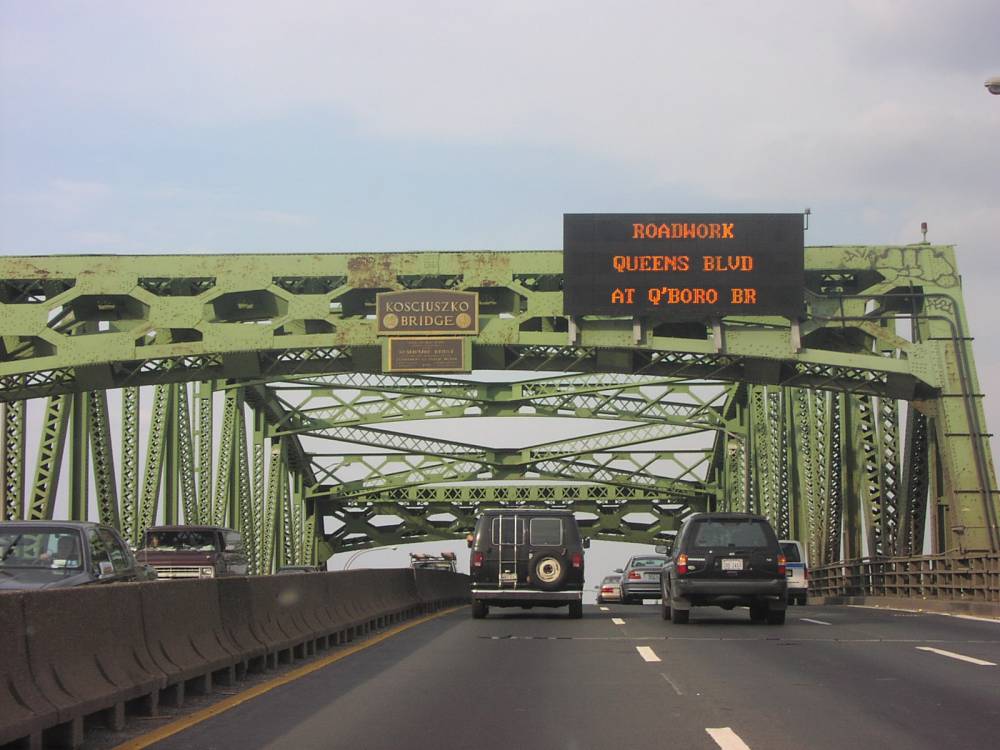 Finally at center span on the old, now history Kosciuszko Bridge. For an old bridge who knew even back in 2001 that the handwriting was on the wall for eventual damnation, the Kosciuszko tried to keep up with the times. It must have thought it was all this and that, Y2K compliant and whatnot, with its smart digital readout hazard warning sign. The Q'Boro is digital signese for the Queensboro Bridge. I never thought of calling it the Q'Boro before. The sign could have copyrighted that and made something.
Maybe if everyone took to calling the Queensboro the Q'boro because they saw it spelled that way on the Kosciuszko, it might not have been torn down and replaced, or rather replaced and torn down. Who knows, the Q'Boro may then have gotten its own flashy digital sign and called the Kosciuszko something catchy, like the Kosky, K'Sko, or K'O. Bridgey the K, the K-Man, the K-Ster, the K-Meister! How are you going to sell people on ripping down the K-Meister, huh? You'd have had bridge huggers chaining themselves to it's supports.
Finally at center span on the old, now history Kosciuszko Bridge. For an old bridge who knew even back in 2001 that the handwriting was on the wall for eventual damnation, the Kosciuszko tried to keep up with the times. It must have thought it was all this and that, Y2K compliant and whatnot, with its smart digital readout hazard warning sign. The Q'Boro is digital signese for the Queensboro Bridge. I never thought of calling it the Q'Boro before. The sign could have copyrighted that and made something.
Maybe if everyone took to calling the Queensboro the Q'boro because they saw it spelled that way on the Kosciuszko, it might not have been torn down and replaced, or rather replaced and torn down. Who knows, the Q'Boro may then have gotten its own flashy digital sign and called the Kosciuszko something catchy, like the Kosky, K'Sko, or K'O. Bridgey the K, the K-Man, the K-Ster, the K-Meister! How are you going to sell people on ripping down the K-Meister, huh? You'd have had bridge huggers chaining themselves to it's supports.